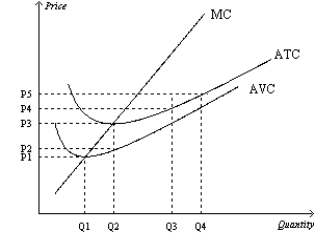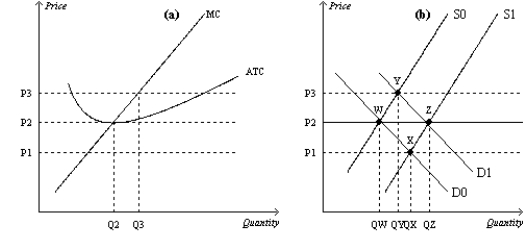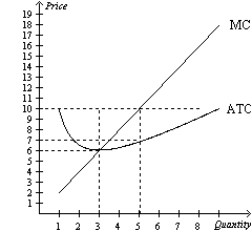A) A only
B) A and C only
C) B only
D) B and D only
Correct Answer

verified
Correct Answer
verified
Multiple Choice
Firms operating in competitive markets produce output levels where marginal revenue equals
A) price.
B) average revenue.
C) total revenue divided by output.
D) All of the above are correct.
Correct Answer

verified
Correct Answer
verified
Multiple Choice
Figure 14-6
Suppose a firm operating in a competitive market has the following cost curves:  -Refer to Figure 14-6. Firms will be encouraged to enter this market for all prices that exceed
-Refer to Figure 14-6. Firms will be encouraged to enter this market for all prices that exceed
A) P1.
B) P2.
C) P3.
D) None of the above is correct.
Correct Answer

verified
Correct Answer
verified
Multiple Choice
Which of the following firms is the closest to being a perfectly competitive firm?
A) a hot dog vendor in New York
B) Microsoft Corporation
C) Ford Motor Company
D) the campus bookstore
Correct Answer

verified
Correct Answer
verified
True/False
Firms operating in perfectly competitive markets produce an output level where marginal revenue equals marginal cost.
Correct Answer

verified
Correct Answer
verified
Multiple Choice
Figure 14-14
 -Refer to Figure 14-14. If the market starts in equilibrium at point Z in panel (b) , a decrease in demand will ultimately lead to
-Refer to Figure 14-14. If the market starts in equilibrium at point Z in panel (b) , a decrease in demand will ultimately lead to
A) more firms in the industry but lower levels of output for each firm.
B) fewer firms in the market.
C) a new long-run equilibrium at point X in panel (b) .
D) lower prices once the new long-run equilibrium is reached.
Correct Answer

verified
Correct Answer
verified
Multiple Choice
Which of the following is not a characteristic of a competitive market?
A) Buyers and sellers are price takers.
B) Each firm sells a virtually identical product.
C) Entry is limited.
D) Each firm chooses an output level that maximizes profits.
Correct Answer

verified
Correct Answer
verified
Multiple Choice
If a profit-maximizing firm in a competitive market discovers that, at its current level of production, price is greater than marginal cost, it should
A) shut down.
B) reduce its output but continue operating.
C) continue to produce at the current levels.
D) increase its output.
Correct Answer

verified
Correct Answer
verified
Multiple Choice
In calculating accounting profit, accountants typically don't include
A) long-run costs.
B) sunk costs.
C) explicit costs of production.
D) opportunity costs that do not involve an outflow of money.
Correct Answer

verified
Correct Answer
verified
Multiple Choice
Figure 14-9
In the figure below, panel (a) depicts the linear marginal cost of a firm in a competitive market, and panel (b) depicts the linear market supply curve for a market with a fixed number of identical firms.
 -Refer to Figure 14-9. If at a market price of $1.75, 52,500 units of output are supplied to this market, how many identical firms are participating in this market?
-Refer to Figure 14-9. If at a market price of $1.75, 52,500 units of output are supplied to this market, how many identical firms are participating in this market?
A) 75
B) 100
C) 250
D) 300
Correct Answer

verified
Correct Answer
verified
Multiple Choice
Total profit for a firm is calculated as
A) marginal revenue minus average total cost.
B) average revenue minus average total cost.
C) marginal revenue minus marginal cost.
D) (price minus average cost) times quantity of output.
Correct Answer

verified
Correct Answer
verified
Multiple Choice
Table 14-5
The table represents a demand curve faced by a firm in a competitive market.
 -Refer to Table 14-5. For this firm, the average revenue when 14 units are produced and sold is
-Refer to Table 14-5. For this firm, the average revenue when 14 units are produced and sold is
A) $11.
B) $9.
C) $13.
D) $15.
Correct Answer

verified
Correct Answer
verified
True/False
The short-run supply curve in a competitive market must be more elastic than the long-run supply curve.
Correct Answer

verified
Correct Answer
verified
True/False
In the long run, a firm should exit the industry if its total costs exceed its total revenues.
Correct Answer

verified
Correct Answer
verified
Multiple Choice
Table 14-11
Suppose that a firm in a competitive market faces the following prices and costs:
 -Refer to Table 14-11. In order to maximize profits, the firm should stop producing after it makes the
-Refer to Table 14-11. In order to maximize profits, the firm should stop producing after it makes the
A) first unit.
B) second unit.
C) fourth unit.
D) fifth unit.
Correct Answer

verified
Correct Answer
verified
Multiple Choice
Robin owns a horse stables and riding academy and gives riding lessons for children at "pony camp." Her business operates in a competitive industry. Robin gives riding lessons to 20 children per month. Her monthly total revenue is $4,000. The marginal cost of pony camp is $200 per child. In order to maximize profits, Robin should
A) give riding lessons to more than 20 children per month.
B) give riding lessons to fewer than 20 children per month.
C) continue to give riding lessons to 20 children per month.
D) We do not have enough information to answer the question.
Correct Answer

verified
Correct Answer
verified
Multiple Choice
Scenario 14-2 Assume a certain firm is producing Q = 1,000 units of output. At Q = 1,000, the firm's marginal cost equals $20 and its average total cost equals $25. The firm sells its output for $30 per unit. -Refer to Scenario 14-2. At Q = 999, the firm's profits equal
A) $4,990.
B) $5,000.
C) $5,020.
D) $5,030.
Correct Answer

verified
Correct Answer
verified
Multiple Choice
Figure 14-3
Suppose a firm operating in a competitive market has the following cost curves:  -Refer to Figure 14-3. If the market price is $10, what is the firm's total cost?
-Refer to Figure 14-3. If the market price is $10, what is the firm's total cost?
A) $15
B) $30
C) $35
D) $50
Correct Answer

verified
Correct Answer
verified
Multiple Choice
If all existing firms and all potential firms have the same cost curves, there are no inputs in limited quantities, and the market is characterized by free entry and exit, then the long-run market supply curve
A) is horizontal and equal to the minimum of long-run marginal cost for each firm.
B) must slope downward.
C) must slope upward.
D) is horizontal and equal to the minimum of long-run average cost for each firm.
Correct Answer

verified
Correct Answer
verified
Multiple Choice
Table 14-1
 -Refer to Table 14-1. Over what range of output is marginal revenue declining?
-Refer to Table 14-1. Over what range of output is marginal revenue declining?
A) 1 to 6 units
B) 3 to 7 units
C) 7 to 9 units
D) Marginal revenue is constant over the entire range of output.
Correct Answer

verified
Correct Answer
verified
Showing 421 - 440 of 543
Related Exams